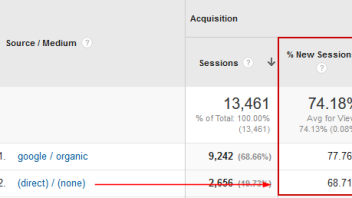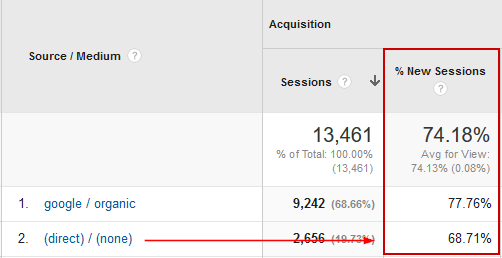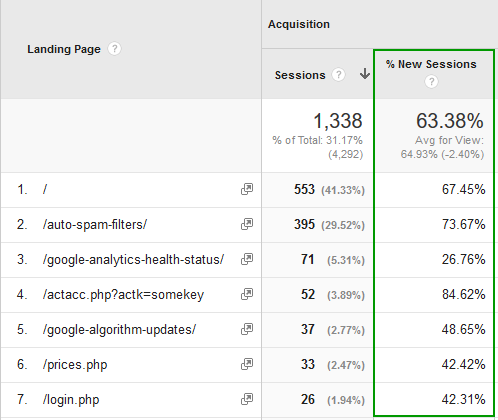When I do a seminar or a training (I am Google Regional Trainer in AdWords & Analytics) direct traffic is often one of the tougher things for the audience to understand. My audience is usually comprised of digital marketers, SEOs, AdWords specialists, and SMB owners so IT/web development background is relatively rare. That’s why when asked what is direct traffic in Google Analytics? they usually say that it’s type-in traffic, just users returning to your site by typing your URL or using bookmarks. And why wouldn’t they say that given that the definition in Google’s own help center states:
“users that typed your URL directly into their browser, or who had bookmarked your site”
However, this definition is highly misleading and inaccurate, as can be demonstrated with a simple screenshot:
These direct traffic sessions are not that different from our organic traffic, right? Tons of new users in the direct segment – this can’t be all from prior users and bookmarks!
In order to understand what “direct / none” in your Source / Medium report really is you need to know at least a bit about the technical side of how Google Analytics is able to say where visitors to your site come from.
How does Google Analytics recognize referrer sources?
The web runs on a number of protocols and one of the most widely used one is HTTP. In it there is a specification for how a browser might pass information about the referring source to a web server:
The Referer[sic] request-header field allows the client to specify, for the server’s benefit, the address (URI) of the resource from which the Request-URI was obtained (the “referrer”, although the header field is misspelled.) The Referer request-header allows a server to generate lists of back-links to resources for interest, logging, optimized caching, etc. It also allows obsolete or mistyped links to be traced for maintenance. The Referer field MUST NOT be sent if the Request-URI was obtained from a source that does not have its own URI, such as input from the user keyboard.
Basically, when a user’s browser is requesting a page on your site it can supply this “Referer” field, which is then accessible to Google Analytics. GA reads and parses the value of the field, processes it and then displays it in your Source / Medium report. Make note that this field is not mandatory and also that it “MUST NOT” be set in case the source doesn’t have a Unique Resource Identifier (URI). This will be important in just a second.
What is Direct traffic in Google Analytics?
The second thing to know in order to understand what direct sessions really represents, is how Google Analytics attributes traffic to traffic sources and mediums. For those with a deeper interest in the subject I highly recommend getting acquainted with the processing flow chart at the bottom of this page from the Google Analytics help center.
Here is the short version of it: GA will check for: AdWords auto-tagging, UTM campaign tagging parameters, and the HTTP referrer field just discussed, in that order. If none of these are set AND if there is no prior campaign data associated with the user’s browser (ID is clientId in the _ga cookie), then Google Analytics will mark such traffic as… wait for it… direct / none .
Direct traffic is traffic for which the referrer is unknown and for which no prior campaign data could be found for the cookie (user).
So direct traffic is not ‘direct’ at all, it’s just unknown, undefined. Google has no idea if your user typed in your URL, if they used a bookmark, or if they reached your website through some other venue. To help that really sink in, let us see what other scenarios might result in the user’s browser not setting the “Referer” field.
The different types of “Direct”, a.k.a. “Unknown” traffic
Here is an incomplete list of the cases in which a user navigates to your site in a way which will result in Google Analytics not knowing where the user came from. In all such cases the sessions will be marked as “direct / none” unless previous campaign data exists for that cookie:
- User types in a URL
- User clicks on a bookmark
- User clicks on a link in an e-mail from Outlook or Thunderbird or similar desktop software
- User clicks on a link in Skype or other desktop messengers
- User clicks on a link in a PDF, DocX, ODF, XLSX or a different type of document.
- User clicks on a link in a mobile app
- User clicks on a link from a secured site (https://something) to your non-secured site (just http://something)
- User clicks through a URL-shortener or in a different scenario where certain JS is being used (rare)
- User clicks on a link in any desktop software in general…
Therefore, there are a plethora of very common cases in which a user will NOT type in your URL and will NOT be using a bookmark and still be tracked as direct traffic in GA. That’s why I think “unknown” is a much better term.
Most of these scenarios are related to other applications forcing the browser to open a link, but in the case of https to http navigation these are users coming from another site who are still not tracked as referral traffic. That’s because in the case of SSL to Non-SSL navigation the browser is required to not pass referral information.
Now that we know what direct / none really is, let’s see what options we have to understand it better and gain some insights into a website’s direct traffic.
Knowing the Unknown: Demystifying Direct Traffic
There are two things one can do in order to see what is in the black box that is direct traffic.
1. Breakdown by Landing Page
The simplest thing that be done immediately and retroactively is to take a look at your landing pages breakdown for the direct / none source/medium dimension.
Here are several questions to ask that landing page data to get you started:
- Are people landing on pages that are only accessible to logged-in users?
- Are they landing on pages that you’ve used in e-mail campaigns or system/operational emails?
- Are users landing on pages to which there are links in your desktop or mobile software (if you’re a desktop or mobile software company)?
Let’s see an example of how such an analysis looks for our own site, www.analytics-toolkit.com:
As will be the general case most direct traffic arrives at the homepage. However, notice the big amounts of it landing on various tool pages, our prices page, login page, and at our account activation page. The % new sessions metric is being very helpful in this case as it varies greatly between landing pages. This suggests very different types of traffic are landing on each of them – some of it is perhaps returning users (low percentage of new sessions) whereas for others with high percentage of new sessions it is most likely this is really referral traffic masquerading as direct.
More advanced Google Analytics users can use the landing pages to define Custom Segments, Custom Channels, and Custom MCF Channels in order to get better idea of the different types of traffic from unknown sources.
2. UTM Campaign Tagging
This is something you can do for direct traffic that is under your control: emails of all kinds, links embedded in desktop software or mobile apps, links in materials distributed as PDFs or other types of documents, affiliate links, etc. Tagging links with _utm parameters will supply Google Analytics with the referral data that accurately reflects the traffic source. You can use Google’s URL builder tool or our own Advanced URL Builder to assist in this task. However, this will only apply for traffic going forward. To analyze prior direct sessions see solution #1 above.
See this in action
Identify potential issues with your analytics setup.
As you can see, understanding direct traffic is not the easiest thing, but it’s not that hard once given a bit of technical background. If you like this article, let me know, as we are planning on releasing a series of these more educational articles in the very near future.
Last Updated Jun 5, 2020: clarity and style improvements.





I wonder if Facebook and Twitter apps redirect the users to URL on their servers first or is this traffic also “Direct”
That’s an interesting issue to check – most apps won’t do it, but there are ways, as you mention.
Useful stuff, illuminating.
how about an article about using utm tags internally to track landing page to target destination page?
That’s a practice I strongly discourage for various reasons. There are better ways to accomplish such tracking and I might do an article on that at some point.
Great explication. Wonder about this traffic type since I started SEO, Very informative and useful post for us. Thank you so much for the blogs.
Any Idea what the difference is between “Unknown” and “Other” as I have both showing in my analytics. Also, does facebook.com show up anymore since it is HTTPS? My website is http and I’m not sure if some of the “Unknown” or “Other” is from Social Media Pages or even Google since Google is also secure?
So if you are using a URL shortner, should you include tagging parameter in the URL you are shortening? For example… all of your social media posts, Twitter, IG, email campaigns, etc.. If you want Google to generate accurate reporting…URLs must be tagged properly?
Great article – now the direct traffic makes much more sense.
Thanks Georgi!